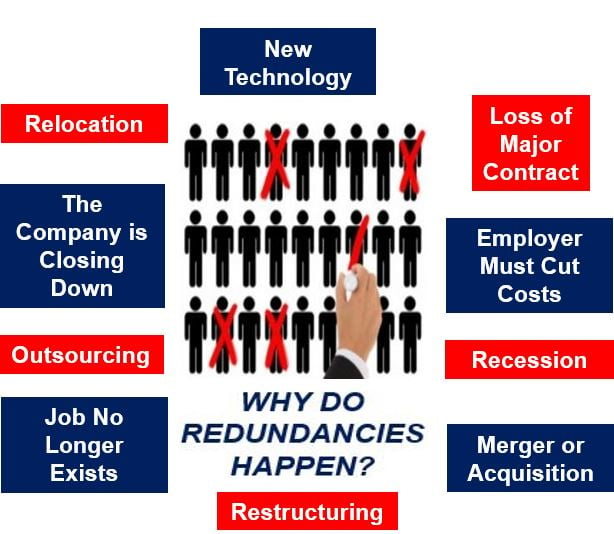What Happens to Redundancy If Company Goes Bust? An Overview to Your Rights
What Happens to Redundancy If Company Goes Bust? An Overview to Your Rights
Blog Article
Exploring the Operational Characteristics of Business Redundancy and Its Long-Term Sustainability

Redundancy Approaches for Service Continuity
In order to make certain undisturbed procedures, businesses need to carry out effective redundancy methods for organization continuity. Redundancy in this context refers to the replication of critical elements or features within a system to minimize the impact of potential failures. By integrating redundancy approaches, organizations can enhance their durability against disturbances brought on by different aspects such as all-natural calamities, equipment failures, or cyber-attacks.
One common redundancy technique is the application of back-up systems and information storage space remedies. This entails developing matches of important data and systems that can be triggered in situation of a main system failure. Furthermore, organizations can develop repetitive interaction networks and source of power to keep connection and procedures throughout unpredicted occasions.
Additionally, cross-training staff members to execute numerous duties within the business can function as a valuable redundancy approach. If vital workers are not available due to disease or other factors, this makes sure that necessary tasks can still be carried out also. Generally, efficient redundancy strategies are essential for organizations to promote operational continuity and decrease the effect of prospective disruptions.
Influence of Redundancy on Organizational Resilience
Given the important role redundancy methods play in making sure service connection, exploring the effect of redundancy on business strength becomes necessary for understanding the holistic operational dynamics of a business. Redundancy, when purposefully applied, can significantly contribute to improving a company's durability in the face of unanticipated obstacles.
Moreover, redundancy can reinforce worker spirits and self-confidence, knowing that there are contingency plans in position to deal with unexpected scenarios. This complacency can bring about raised performance and an extra favorable workplace. Furthermore, redundancy can promote advancement and imagination within an organization as employees feel empowered to take computed threats, recognizing that there is a safeguard to support them in case of failure. Overall, the influence of redundancy on business durability is profound, forming the lasting sustainability and success of a business.
Balancing Effectiveness and Flexibility in Redundancy
Achieving an unified equilibrium in between operational performance and adaptive flexibility is a crucial difficulty in the strategic implementation of redundancy within organizations. Reliable operations are essential for keeping efficiency and cost-effectiveness, ensuring that sources are utilized efficiently. However, extreme emphasis on effectiveness alone can lead to rigidness, making it difficult for companies to adjust to unanticipated changes or difficulties. On the other hand, versatility permits organizations to react nimbly to evolving scenarios, fostering advancement and resilience. Yet, excessive adaptability without a solid operational foundation can cause ineffectiveness and inconsistency.
To stabilize effectiveness and adaptability in redundancy preparation, companies need to thoroughly evaluate their functional requirements, market dynamics, and critical objectives. Inevitably, discovering the right stability between efficiency and adaptability is vital for constructing a resilient and sustainable company in the face of uncertainty.
Long-Term Sustainability Via Redundancy Planning
To guarantee enduring feasibility and stability, companies should strategically straighten their redundancy planning with lasting sustainability goals, therefore balancing functional efficiency with flexible flexibility. Lasting sustainability through redundancy preparation involves greater than just temporary cost-cutting measures. It calls for an extensive critical method that prepares for future challenges and chances. Companies ought to view redundancy not as a responsive solution to instant problems however as a proactive approach for long-lasting success. By integrating redundancy preparation with sustainability objectives, companies can create a resistant framework that can stand up to numerous market changes and inner modifications.

Aggressive Measures for Sustainable Firm Operations
Exactly how can firms proactively enhance their functional sustainability for lasting success? Executing positive actions is vital for firms intending to make sure lasting procedures. One essential method is to spend in modern technology and development to enhance procedures, lower waste, and stay competitive on the market. Adopting sustainable techniques such as minimizing energy intake, reducing carbon impact, and enhancing source usage can not just profit the setting yet also cause cost savings in the long run.
Moreover, promoting a culture of continuous improvement and learning within the company can boost versatility to altering market conditions and consumer needs. Motivating employee participation in decision-making procedures and supplying check out this site chances for professional growth can improve morale, productivity, and total performance. Establishing clear objectives, monitoring vital efficiency indicators, and routinely evaluating progression are crucial elements of proactive sustainability monitoring.
Working together with suppliers, customers, and various other stakeholders to advertise lasting methods throughout the supply chain can create a causal Going Here sequence of positive influence - redundancy pay if company goes bust. By taking aggressive actions towards operational sustainability, firms can construct durability, drive development, and protect their lasting success in an ever-evolving company landscape
Conclusion

In the realm of business monitoring, the calculated release of business redundancy stands as a critical yet elaborate technique that requires a delicate equilibrium between functional performance and long-term stability. By exploring the operational dynamics that underpin firm redundancy and assessing its more comprehensive ramifications for organizational resilience and adaptability, a nuanced understanding of just how redundancy methods can shape the future trajectory of a business begins to unfold.Offered the important role redundancy methods play in guaranteeing organization continuity, checking out the influence of redundancy on organizational resilience ends up being important for recognizing the alternative functional characteristics of a business. Generally, the impact of redundancy on organizational durability is extensive, forming the long-term sustainability and success of a business.
In verdict, understanding the operational dynamics read the full info here of business redundancy is critical for guaranteeing long-lasting sustainability.
Report this page